4 GROUPERS
Introduction and species identification
Groupers (class Actinopterygii, order Perciformes, family Serranidae, subfamily Epinephelinae) are classified in 14 genera of the subfamily Epinephelinae, that comprises at least half the 449 species in the family Serranidae (Tucker 1999). There are 15 major grouper species that are cultured; the dominant species varies somewhat regionally.
The most consistently abundant species that are captured for culture purposes and also reared in hatcheries are Epinephelus coioides and E. malabaricus. Other important species are E. bleekeri, E. akaara, E. awoara and E. areolatus. Also cultured in smaller amounts are E. amblycephalus, E. fuscoguttatus,
E. lanceolatus, E. sexfasciatus, E. trimaculatus, E. quoyanus, E. bruneus, Cromileptes altivelis, Plectropomus leopardus and P. maculatus. In the literature, E. tauvina is often referred to but it is very probably a misidentification of E. coioides (or E. malabaricus), as it has not been confirmed from most economies in the region, with the exception of Taiwan Province of China (Heemstra and Randall 1993). Moreover, reports of E. akaara caught in central and southern Viet Nam may be misidentifications of E. fasciatomaculosus (Sadovy 2000). In the south eastern USA and the Caribbean, E. striatus, E. itajara, Mycteroperca microlepis and M. bonaci seem to have good farming potential (Tucker 1999).
Juveniles and adults of some grouper species live in coastal waters and estuaries, while others prefer the cleaner waters of offshore reefs. Their eggs are single, non-adhesive, and buoyant at normal salinities. The larvae of most species spend at least their first few weeks drifting with the oceanic plankton. As they become juveniles, groupers settle in shallow waters where they can find hiding places. At first, wild grouper larvae eat copepods and other small zooplankton, then larger crustaceans - amphipods and mysid shrimp. Wild juveniles and adults eat fish, crabs, shrimp, mantis shrimp, lobsters and molluscs (Tucker 1999).
The maximum size ranges from 12 cm for Pacific groupers (e.g. Paranthias colonus) to more than 4 m (e.g. Epinephelus lanceolatus); most groupers that have been studied mature within 2-6 years. Most serranids are protogynous hermaphrodites. As a rule, some change from female to male as they grow older; others may change only if there is a shortage of males. In nature, species like the Nassau grouper (E. striatus) spawn in large aggregations (hundreds to thousands of fish) with a sex ratio nearing 1:1 (Sadovy and Eklund 1999).
Groupers are some of the top predators on coral reefs, and tend to be piscivorous K-strategists demonstrating slow growth, late reproduction, large size and long life-spans which make them vulnerable to over-exploitation. They are sedentary in character and strongly territorial (Bullock et al. 1992; Heemstra and Randall 1993; Sadovy 1996; Domeier and Colin 1997; Sadovy and Eklund 1999; Morris, Roberts and Hawkins 2000). Tables 29-36 summarize the characteristics of these species, while Figures 40-55 illustrate their appearance and geographical location.
Epinephelus coioides (Hamilton, 1822)
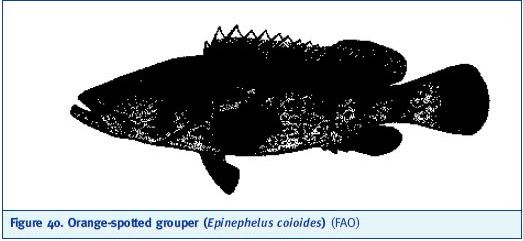
Figure 40. Orange-spotted grouper (Epinephelus coioides) (FAO)
Table 29. Characteristics of the Orange-spotted grouper (Epinephelus coioides) (FishBase 2002, modified)
Common name Orange-spotted grouper.
Size and age Maximum length of 100 cm SL (male/unsexed); maximum weight of 15 kg; can live for 22 years.
Environment Lives in brackish and marine waters; lives to a depth of 100 m.
Climate and latitude Subtropical (38°N-33°S).
Resilience Population doubling time of 1.4-4.4 years, with medium resilience.
Distribution Indo-West Pacific, south to at least Durban, south Africa and eastward to Palau and Fiji, north to the Ryukyu Islands, south to the Arafura Sea (Russell and Houston 1989) and Australia.
Biology and ecology Present in turbid coastal reefs (Lieske and Myers 1994) and in brackish water (Randall, Allen and Steene 1997) over mud and rubble (Kailola et al. 1993). Eats larval stage of crustaceans, larger crustaceans, fish, and molluscs (Tucker 1999). Probably form aggregations during spawning.
Importance Represents an important species for fisheries and aquaculture (Heemstra and Randall 1993). Considered vulnerable (Morris, Roberts and Hawkins 2000).
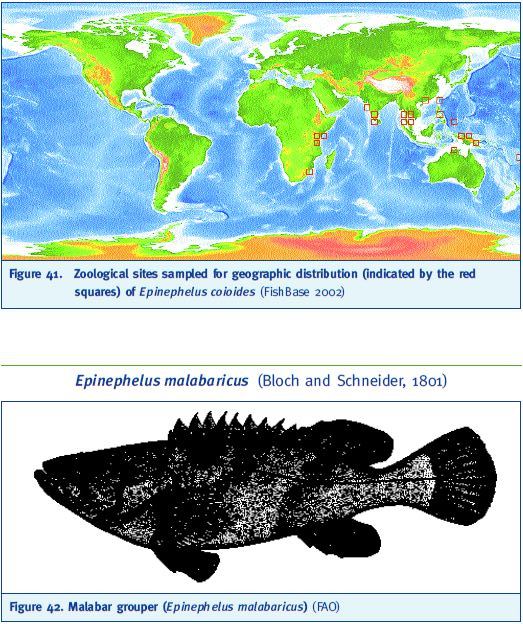
Figure 41. Zoological sites sampled for geographic distribution (indicated by the red squares) of Epinephelus coioides (FishBase 2002)
Epinephelus malabaricus (Bloch and Schneider, 1801)
Figure 42. Malabar grouper (Epinephelus malabaricus) (FAO)
Table 30. Characteristics of the Malabar grouper (Epinephelus malabaricus) (FishBase 2002, modified)
Common name Malabar grouper.
Size and age Maximum length 234 cm TL (male/unsexed); maximum weight 150 kg. Brackish and marine species, between shoreline and 150 m.
Environment Tropical (35°N-35°S).
Climate and latitude Resilience No information available
Distribution Indo-Pacific: Red Sea and East Africa to Tonga, north to Japan, south to Australia.
Biology and ecology Found in a variety of habitats: coral and rocky reefs, tidal pools, estuaries, mangrove swamps and sandy/mud bottoms. Feeds primarily on fish and crustaceans, and occasionally on cephalopods (Lieske and Myers 1994).
Importance Very important for fisheries because it is present in the Hong Kong live fish markets, and also for aquaculture (Lee and Sadovy 1998). Considered vulnerable (Morris, Roberts and Hawkins 2000).
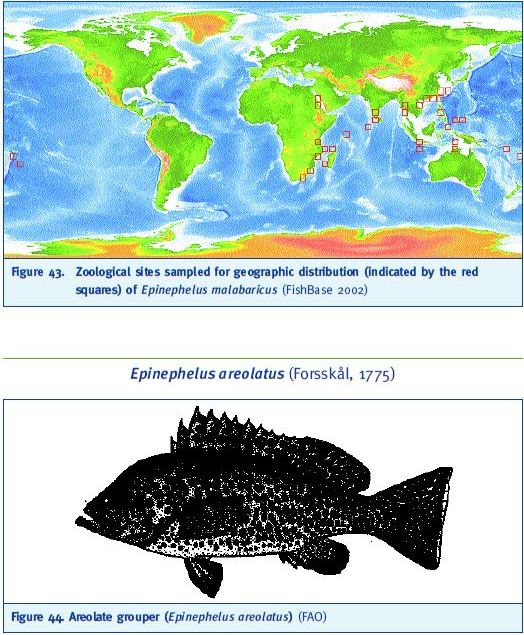
Figure 43. Zoological sites sampled for geographic distribution (indicated by the red squares) of Epinephelus malabaricus (FishBase 2002)
Epinephelus areolatus (Forsskal, 1775)
Figure 44. Areolate grouper (Epinephelus areolatus) (FAO)
Table 31. Characteristics of the Areolate grouper (Epinephelus areolatus) (FishBase 2002, modified)
Common name Areolate grouper.
Size and age Maximum length 47 cm TL (male/unsexed max. size); maximum weight 1.4 kg. Heemstra and Randall (1993) report maximum age of 15 years.
Environment Marine, between 6-200 m.
Climate and latitude Tropical (37°N-35°S).
Resilience Population doubling time of 1.4-4.4 years, with medium resilience.
Distribution Red Sea, Persian Gulf, and western Indian Ocean, south to Natal, South Africa Fiji, north to Japan, south to the Arafura Sea (Russell and Houston 1989) and northern Australia.
Biology and ecology Found in sea-grass beds or on fine sediment bottoms near rocky reefs, dead coral, or alcyonarians (Heemstra and Randall 1993), in shallow continental shelf waters (Leis 1987). Feeds on fish and benthic invertebrates, primarily prawns and crabs (Randall and Heemstra 1991; Parrish 1987).
Importance Commercially important species for fisheries and aquaculture. Considered a lower risk species (Morris, Roberts and Hawkins 2000).

Figure 45. Zoological sites sampled for geographic distribution (indicated by the red squares) of Epinephelus areolatus (FishBase 2002)
Epinephelus striatus (Bloch, 1792)

Figure 46. Nassau grouper (Epinephelus striatus) (FAO)
Table 32. Characteristics of the Nassau grouper (Epinephelus striatus) (FishBase 2002, modified)
Common name Nassau grouper.
Size and age Maximum length 122 cm TL (male/unsexed); maximum weight 25 kg; can live for 16 years.
Environment Marine, down to 90 m.
Climate and latitude Tropical (35°N-15°N).
Resilience Population doubling time 4.5-14 years, with low resilience (Musick et al. 2000).
Distribution Bermuda, Florida, Bahamas, Yucatan Peninsula and throughout the Caribbean to southern Brazil. In the Gulf of Mexico present only at the Campeche Bank off the coast of Yucatan, at Tortugas and off Key West (Heemstra and Randall 1993).
Biology and ecology Close to reef, caves and in sea-grass beds (Lieske and Myers 1994). Solitary and diurnal. Eats fish (54%) and crabs (23%) and lesser amounts of other crustaceans and molluscs. Spawns near the new moon with up to 30 000 aggregating at certain spawning sites (Lieske and Myers 1994).
Importance Represents the most important commercial grouper in the West Central Atlantic and for this reason is heavily fished without considering its vulnerability to overfishing. Considered endangered (Morris, Roberts and Hawkins 2000). In the market it is requested fresh, mostly between 2 to 10 kg (Smith 1978).
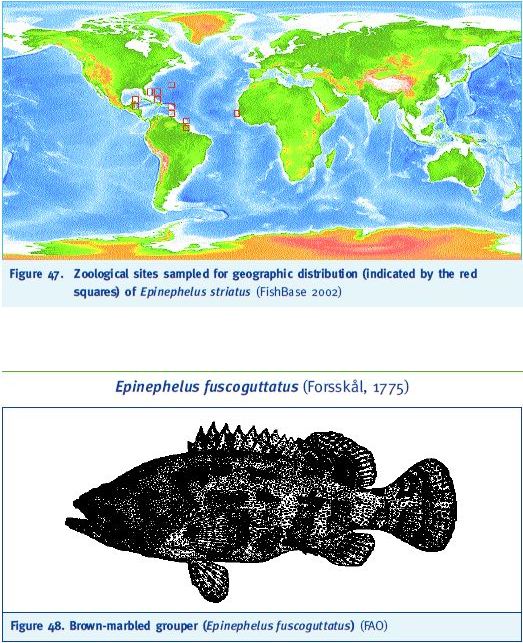
Figure 47. Zoological sites sampled for geographic distribution (indicated by the red squares) of Epinephelus striatus (FishBase 2002)
Epinephelus fuscoguttatus (Forsskal, 1775)
Figure 48. Brown-marbled grouper (Epinephelus fuscoguttatus) (FAO)
Table 33. Characteristics of the Brown-marbled grouper (Epinephelus fuscoguttatus) (FishBase 2002, modified)
Common name Brown-marbled grouper.
Size and age Maximum length 120 cm TL (male/unsexed); maximum weight 11 kg.
Environment Marine.
Climate and latitude Tropical, 35°N-35°S.
Resilience Population doubling time 1.4-4.4 years with medium resilience (Heemstra and Randall 1993)
Distribution Red Sea and along the east coast of Africa to Mozambique; east to Samoa and the Phoenix Islands, north to Japan, south to Australia.
Biology and ecology Occurs in lagoon pinnacles, channels, and outer reef slopes, in coral-rich areas and with clear waters, and in sea-grass beds. Feeds on fish, crabs, and cephalopods.
Importance Important in the Philippines, where it is cultured in experimental conditions and represented in the Hong Kong live fish markets (Leis 1987). Considered vulnerable (Morris, Roberts and Hawkins 2000)
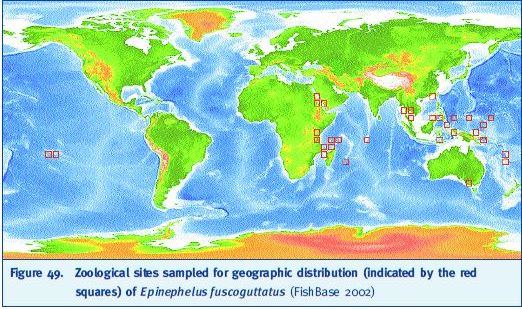
Figure 49. Zoological sites sampled for geographic distribution (indicated by the red squares) of Epinephelus fuscoguttatus (FishBase 2002)
Epinephelus itajara (Lichtenstein, 1822)

Figure 50. Goliath grouper (Epinephelus itajara) (FAO)
Table 34. Characteristics of the Goliath grouper (Epinephelus itajara) (FishBase 2002, modified)
Common name Goliath grouper.
Size and age Maximum length 250 cm TL (male/unsexed); maximum weight 455 kg.
Environment Reef-associated; brackish and marine waters down to 100 m.
Climate and latitude Subtropical (35°N-25°S).
Resilience Population doubling time 4.5-14 years, with low resilience (Heemstra and Randall 1993).
Distribution Western Atlantic: Florida, USA to southern Brazil and Eastern Atlantic, including Gulf of Mexico and the Caribbean.
Biology and ecology Solitary species (Claro 1994) living in shallow, inshore areas such as estuaries (Cervigon et al. 1992), on hard bottoms such as rock, coral, or mud, in mangrove areas and brackish estuaries (Cervigon et al. 1992). Feeds on crustaceans, as well as turtles and fish, including stingrays.
Importance It is an over fished species and critically endangered (UNEP classification A1d+2d) (Hilton-Taylor 2000). The meat is of excellent quality and it is sold fresh and salted.
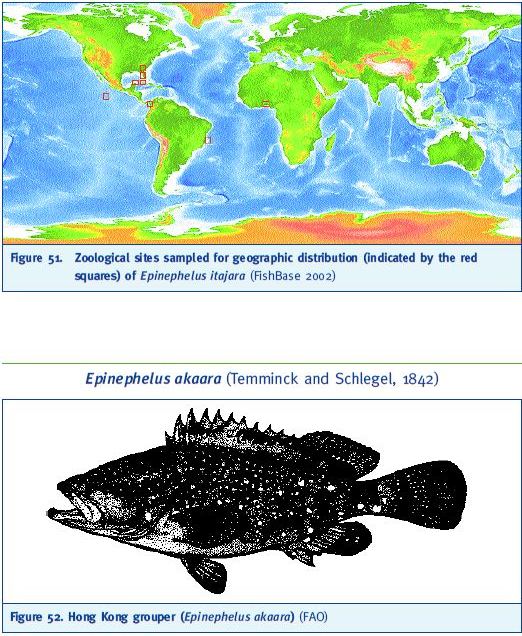
Figure 51. Zoological sites sampled for geographic distribution (indicated by the red squares) of Epinephelus itajara (FishBase 2002)
Epinephelus akaara (Temminck and Schlegel, 1842)
Figure 52. Hong Kong grouper (Epinephelus akaara) (FAO)
Table 35. Characteristics of the Hong Kong grouper (Epinephelus akaara) (FishBase 2002, modified)
Common name Hong Kong grouper.
Size and age Maximum length 53 cm TL (male/unsexed); maximum weight 2.5 kg.
Environment Marine.
Climate and latitude Tropical, 40°N-21°N.
Resilience Population doubling time of 1.4 - 4.4 years and medium resilience (Heemstra and Randall 1993).
Distribution Southern China, Taiwan Province of China, East China Sea, Korea, and southern Japan (Kyushu to about 38°N on both coasts of Honshu) (Heemstra and Randall 1993).
Biology and ecology Lives over rock strata in reefs.
Importance Highly prized food fish sold in Hong Kong live fish markets (Lee and Sadovy 1998); also important for aquaculture. Considered vulnerable (Morris, Roberts and Hawkins 2000).
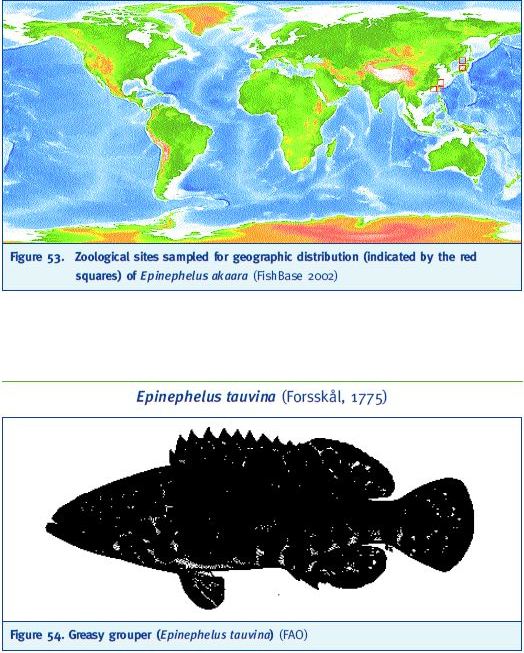
Figure 53. Zoological sites sampled for geographic distribution (indicated by the red squares) of Epinephelus akaara (FishBase 2002)
Epinephelus tauvina (Forsskal, 1775)
Figure 54. Greasy grouper (Epinephelus tauvina) (FAO)
Table 36. Characteristics of the Greasy grouper (Epinephelus tauvina) (FishBase 2002, modified)
Common name Greasy grouper.
Size and age Maximum length 107 cm TL (male/unsexed); maximum weight 12 kg.
Environment Marine, living between 1 and 300 m (Allen and Steene 1988).
Climate and latitude Subtropical, 35°N-36°S).
Resilience Population doubling time 4.5-14 years, with low resilience (Heemstra and Randall 1993).
Distribution Red Sea to South Africa and eastward to Ducie in the Pitcairn Group, north to Japan, south to New South Wales and Lord Howe Island
Biology and ecology Lives in clear water areas on coral reefs. Usually feeds on fish.
Importance Important in fisheries and aquaculture and can be found in the Hong Kong live fish markets (Lee and Sadovy 1998). Considered a lower risk species (Morris, Roberts and Hawkins 2000).
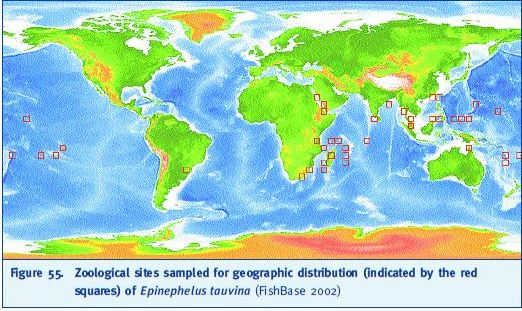
Figure 55. Zoological sites sampled for geographic distribution (indicated by the red squares) of Epinephelus tauvina (FishBase 2002)